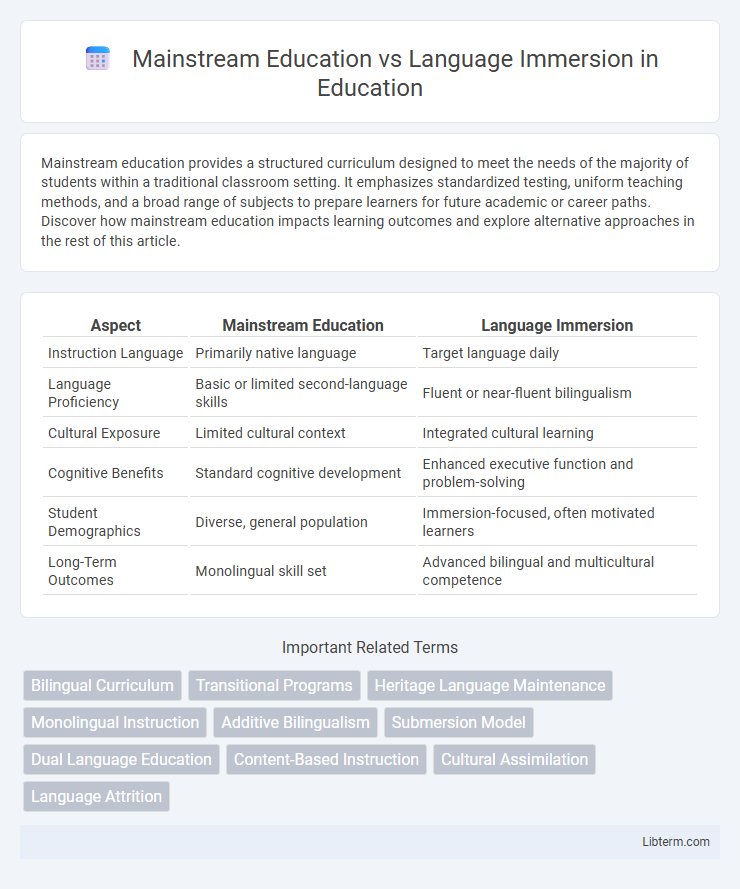Mainstream education provides a structured curriculum designed to meet the needs of the majority of students within a traditional classroom setting. It emphasizes standardized testing, uniform teaching methods, and a broad range of subjects to prepare learners for future academic or career paths. Discover how mainstream education impacts learning outcomes and explore alternative approaches in the rest of this article.
Table of Comparison
| Aspect | Mainstream Education | Language Immersion |
|---|---|---|
| Instruction Language | Primarily native language | Target language daily |
| Language Proficiency | Basic or limited second-language skills | Fluent or near-fluent bilingualism |
| Cultural Exposure | Limited cultural context | Integrated cultural learning |
| Cognitive Benefits | Standard cognitive development | Enhanced executive function and problem-solving |
| Student Demographics | Diverse, general population | Immersion-focused, often motivated learners |
| Long-Term Outcomes | Monolingual skill set | Advanced bilingual and multicultural competence |
Understanding Mainstream Education: A Brief Overview
Mainstream education typically follows a standardized curriculum designed to meet broad academic standards and social development goals for diverse student populations. It emphasizes core subjects such as mathematics, science, language arts, and social studies, delivered predominantly in the dominant language of instruction. This approach aims to prepare students for higher education and workforce integration by fostering general knowledge and critical thinking skills within a structured classroom environment.
What Is Language Immersion? Key Concepts
Language immersion is an educational approach where students are instructed primarily in a target language, enabling natural acquisition through consistent exposure. Key concepts include bilingualism, cultural competence, and cognitive flexibility, as immersion programs emphasize communicative skills and contextual learning. This method contrasts with mainstream education by integrating language and content instruction, fostering proficiency and fluency rather than isolated language study.
Core Differences Between Mainstream and Immersion Programs
Mainstream education primarily uses the students' native language as the medium of instruction, focusing on standard academic subjects with language taught as a separate class. Language immersion programs integrate the target language into the entire curriculum, promoting bilingual proficiency and cultural understanding through consistent exposure. Core differences include the language of instruction, cultural emphasis, and the development of language skills embedded directly in daily academic learning.
Academic Outcomes: Comparing Student Performance
Language immersion programs consistently demonstrate higher proficiency in second language acquisition compared to mainstream education, often leading to improved cognitive flexibility and problem-solving skills. Students in immersion settings tend to perform equally well or better in math and reading assessments, highlighting the academic rigor maintained alongside language development. Mainstream education, while effective in foundational skills, often lacks the dual-language advantage that immersion provides, influencing long-term academic and professional opportunities.
Cognitive Benefits: Bilingualism vs. Monolingualism
Bilingualism developed through language immersion programs enhances cognitive flexibility, problem-solving skills, and executive function compared to monolingualism common in mainstream education. Research indicates that bilingual individuals exhibit improved attention control, memory retention, and multitasking abilities due to constant language switching. These cognitive benefits provide long-term advantages in academic performance and mental agility.
Cultural Awareness and Global Competence
Language immersion programs enhance cultural awareness by providing students with direct exposure to diverse customs, traditions, and social norms through immersive experiences and language practice. Mainstream education often integrates cultural elements superficially, limiting students' ability to develop deep global competence and authentic communication skills. Immersion fosters cognitive flexibility and empathy, critical for navigating multicultural environments and succeeding in an interconnected world.
Social Development in Diverse Learning Environments
Language immersion programs foster enhanced social development by encouraging students to interact across cultural and linguistic boundaries, promoting empathy and global awareness. Mainstream education, while providing broad social exposure, may lack the intensive cultural integration found in immersion settings, potentially limiting opportunities for deep cross-cultural communication skills. Studies show that students in language immersion environments often develop stronger interpersonal skills and adaptability in diverse social contexts compared to their mainstream counterparts.
Teacher Qualifications and Instructional Methods
Teacher qualifications in mainstream education typically include state certification with a focus on standardized curriculum delivery, while language immersion programs require educators to possess bilingual proficiency and specialized training in second language acquisition. Instructional methods in mainstream classrooms emphasize content mastery through direct instruction and assessment-driven approaches, contrasting with language immersion's use of contextualized, immersive communication techniques to enhance language fluency. These differing educator credentials and pedagogical strategies directly impact student engagement and language development outcomes.
Parental Involvement and Community Support
Parental involvement in language immersion programs often drives higher student engagement and achievement compared to mainstream education, where participation may be less intensive. Community support plays a crucial role in immersion settings by providing cultural resources and authentic language experiences that enhance learning outcomes. These factors create a more immersive and sustained linguistic environment, benefiting students' language proficiency and cultural understanding.
Choosing the Right Path: Factors to Consider
Selecting between mainstream education and language immersion depends on a child's learning style, cultural exposure, and long-term language goals. Mainstream education offers a broad curriculum with native language instruction, fostering foundational academic skills, while language immersion programs enhance bilingual proficiency and cognitive flexibility through consistent second-language exposure. Parents should evaluate factors such as access to qualified bilingual teachers, community support, and the child's adaptability to ensure the chosen path aligns with educational and linguistic development objectives.
Mainstream Education Infographic

 libterm.com
libterm.com